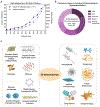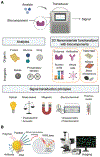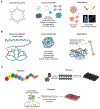Emerging 2D Nanomaterials for Biomedical Applications
- PMID: 34970073
- PMCID: PMC8713997
- DOI: 10.1016/j.mattod.2021.04.020
Emerging 2D Nanomaterials for Biomedical Applications
Abstract
Two-dimensional (2D) nanomaterials are an emerging class of biomaterials with remarkable potential for biomedical applications. The planar topography of these nanomaterials confers unique physical, chemical, electronic and optical properties, making them attractive candidates for therapeutic delivery, biosensing, bioimaging, regenerative medicine, and additive manufacturing strategies. The high surface-to-volume ratio of 2D nanomaterials promotes enhanced interactions with biomolecules and cells. A range of 2D nanomaterials, including transition metal dichalcogenides (TMDs), layered double hydroxides (LDHs), layered silicates (nanoclays), 2D metal carbides and nitrides (MXenes), metal-organic framework (MOFs), covalent organic frameworks (COFs) and polymer nanosheets have been investigated for their potential in biomedical applications. Here, we will critically evaluate recent advances of 2D nanomaterial strategies in biomedical engineering and discuss emerging approaches and current limitations associated with these nanomaterials. Due to their unique physical, chemical, and biological properties, this new class of nanomaterials has the potential to become a platform technology in regenerative medicine and other biomedical applications.
Keywords: bioengineering; drug delivery; nanomaterials; regenerative medicine; two dimensional (2D).
Figures









References
-
- Boehm H-P, et al., Zeitschrift fur anorganische und allgemeine Chemie (1962) 316 (3-4), 119
-
- Novoselov KS, et al., science (2004) 306 (5696), 666. - PubMed
-
- Geim AK, and Novoselov KS, The rise of graphene. In Nanoscience and technology: a collection of reviews from nature journals, World Scientific; (2010), pp 11
-
- Chimene D, et al., Advanced Materials (2015) 27 (45), 7261. - PubMed
-
- Coleman JN, et al., Science (2011) 331, 568. - PubMed
Grants and funding
LinkOut - more resources
Full Text Sources
Other Literature Sources
